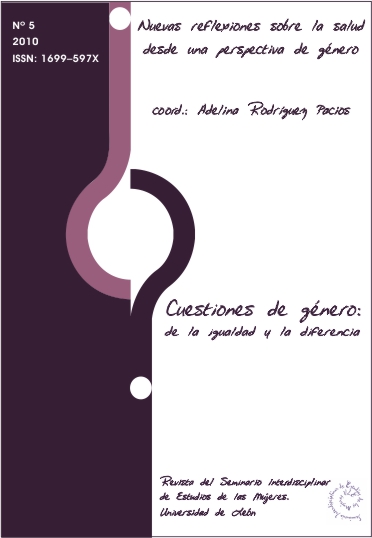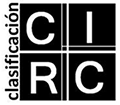Efecto de la estigmatización del VIH/SIDA en usuarios de drogas intravenosas en el acceso a los servicios sanitarios según género
DOI :
https://doi.org/10.18002/cg.v0i5.3790Mots-clés :
estigmatización, pacientes VIH, atención sanitaria esporádica, cuestiones de género, usuarios de drogas, stigmatization, HIV patients, occasional health-care, gender issues, drug abusersRésumé
Se ha elaborado un estudio con enfoque cualitativo basado en encuestas semiestructuradas, en el periodo 2007-2008, de usuarios de drogas intravenosas de los Centros de Información y Prevención del Sida. Los profesionales, que atienden de forma esporádica a pacientes VIH los estigmatizan en mayor medida debido a la desinformación, miedo y falta de empatía. Se detecta diferente comportamiento de uso en ex consumidores de drogas. Las mujeres se ajustan más a las normas y son menos conflictivas, se desenganchan más y recaen menos. A las mujeres se les atiende rápidamente en los servicios sanitarios no específicos. Ambos sexos usan estrategias contra la estigmatización.
Téléchargements
Métricas alternativas
Références
Barnard, M. A. (1993): “Needle sharing in context: patterns of sharing among men and women injectors and HIV risks”. En Addiction, jun, vol. 88, nº. 6, pp. 805-12.
Carr, R. L y Gramling, L. F. (2004): “Stigma: a health barrier for women with HIV/AIDS”. En Journal of the Association of Nurses in AIDS Care- JANAC, set-oct, vol. 15, nº. 5, pp. 30-9.
Carrieri, M. P. (1999): “Access to antiretroviral treatment among French HIV infected injection drug users: the influence of continued drug use. MANIF 2000 Study Group”. En Journal of Epidemiiology and Community Health, nov, vol. 53, nº. 11, p. 739.
Corrigan, P. W. y Watson, A. C. (2002): “Understanding the impact f stigma on people with mental illness”. En World Psychiatry, feb, vol, 1, nº. 1, pp. 16-20.
Dahlgren, L; Emmelin, M. y Winkvist, A. (2004): Qualitative methodology for international public health. Umea: Print and Media, Umea University.
Emlet, C. A. (2006): “A comparison of HIV stigma and disclosure patterns between older and younger adults living with HIV/AIDS”. En AIDS Patient Care and STDS, may, vol. 20, nº. 5, pp. 350-8.
France, L. y Kazatchkine, M. D. (2007): “Antirretroviral HIV treatment and care for injecting drug users: an evidence-based overview”. En The International Journal on Drug Police, aug, vol. 18, nº. 4, pp. 255-61.
Goffman, E. (1963): Notes on the Management of spoiled identify. Englowood Cliffs, Nj: Prentice-Hall.
Harvey, E. et al. (1998): “A qualitative investigation into an HIV outbreak among injection drug users in Vancouver, British Columbia”. En AIDS Care, jun, vol. 10, nº. 3, pp. 313-21.
Herek, G. M; Capitanio, J. P. y Widaman, K. F. (2002): “HIV-Related Stigma and Knowledge in the United States: Prevalence and Trends, 1991–1999”. En American Journal of Public Health, mar, vol. 92, nº. 3, pp. 371-7.
Holzemer, W. L. y Uys, L. (2004): Managing AIDS stigma. En Journal of Social Aspects of HIV/AIDS, vol. 1, nº. 3, pp. 165-175.
Hunter, G. M. y Judd, A. (1998): “Women injecting drug users in London: The extent and nature of their contact with drug and health services”. En Drug and Alcohol Review, sep, vol. 17, nº. 3, pp. 267-76.
Jacoby, A. (1994): “Felt versus enacted stigma: A concept revisited”. En Social Science and Medicine, jan, vol. 38, nº. 2, pp. 269-74.
Kinsler, J; Wong, M; Sayles, J y Davis, C. (2007): “Cunningham W. The effect of perceived stigma from a health care provider on access to care among a low-income hiv-positive population”. En AIDS Patient Care and STDs, aug, vol. 21, nº. 12, pp. 584-92.
Knowlton, A. R. et al. (2001): “Access to medical care and service utilization among injection drug users with HIV/AIDS”. En Drug and Alcohol Dependence, set 1, vol. 64, nº. 1, pp. 55–62.
Lundgren, L. et al. (2005): “Factors Associated with Emergency Room Use among Injection Drug Users of African-American, Hispanic and White European Background”. En American Journal on Addictions, may, vol. 14, nº. 3, pp. 268-280.
Makoae, L. N. et al. (2008): “Coping with HIV-related stigma in five African Countries”. En Journal of the Association of Nurses in AIDS Care- JANAC , mar-apr, vol. 19, nº. 2, pp. 137-46.
Neale J, Sheard L. y Tompkins, C. (2007): “Factors that help injecting drug users to access and benefit from services: A qualitative study”. En Substance Abuse Treatment Prevention and Policy, oct, vol. 2, p. 31.
Peretti-Watel, P. (2006): “Management of HIV-related stigma and adherence to HAART: evidence from a large representative sample of outpatients attending French hospitals (ANRS-EN12-VESPA 2003)”. En AIDS Care, apr, vol. 18, nº. 3, pp. 254-61.
Rintamaki L. S. (2006): “Social stigma concerns and HIV medication adherence”. En AIDS Patient Care STDS, may, vol. 20, nº. 5, pp. 359-68.
Sayles, J. N. (2007): “Experiences of Social Stigma and Implications For Healthcare Among a Diverse Population of HIV Positive Adults”. En Journal of Urban Health: Bulletin of the New York Academy of Medicine, nov, vol. 84, nº. 6, pp. 814-28.
Schneider, J. et al. (2004): “Better physician-patient relationships are associated with higher reported adherence to antiretroviral therapy in patients with HIV infection”. En Journal of General Internal Medicine, vol. 19, nº. 11, pp. 1096-1103.
Sholer N.; Li X. y Cunningham, C. (2007): “Perceived discrimination among severely disadvantaged people with HIV infection”. En Public Health Reports, may-jun, vol. 122, nº. 3, pp. 347-55.
Strathdee, S. A. et al. (1997): “Social determinants predicts needle-sharing behavior among injection drug users in Vancouver, Canada”. En Addiction, oct, vol. 92, nº. 10, pp. 1339-47.
Strauss, A. y Corbin, B. (1990): Basis of qualitative research: Grounded theory procedures and techniques. Newbury Park, CA and London: Sage Publications.
UNAIDS (2005): HIV-Related Sigma, Discrimination and Human Rights Violation: Case Studies of Successful Programs. Geneva, Switzerland: Joint United Nations Program HIV/AIDS.
Ware, N. C.; Wyatt, M. A. y Tugenberg, T. (2005): “Adherence, stereotyping and unequal HIV treatment for active users of illegal drugs”. En Social Science & Medicine, aug, vol. 61, nº. 3, pp. 565-76.
Téléchargements
Publié-e
Comment citer
Numéro
Rubrique
Licence
(c) Tous droits réservés Elizabeth Mora Torres, Yina Lizeth García López, Manuela García de la Hera, María del Carmen Davó 2010

Cette œuvre est sous licence Creative Commons Attribution - Pas d'Utilisation Commerciale - Partage dans les Mêmes Conditions 4.0 International.
L@s autores/as que publican en esta revista están de acuerdo con los siguientes términos:
1. L@s autores/as ceden de forma no exclusiva los derechos de explotación (reproducción, distribución, comunicación pública, transformación) a la Universidad de León, por lo que pueden establecer, por separado, acuerdos adicionales para la distribución no exclusiva de la versión de la obra publicada en la revista (por ejemplo, alojarlo en un repositorio institucional o publicarlo en un libro), con un reconocimiento de su publicación inicial en esta revista.
2. Este trabajo se encuentra bajo la Creative Commons Attribution-NonCommercial-ShareAlike 4.0 International License. Puede consultarse desde aquí la versión informativa y el texto legal de la licencia.
3. Se permite y se anima a l@s autores/as a difundir electrónicamente las versiones pre-print (versión antes de ser evaluada) y/o post-print (versión evaluada y aceptada para su publicación) de sus obras antes de su publicación, ya que favorece su circulación y difusión más temprana y con ello un posible aumento en su citación y alcance entre la comunidad académica.
Cuestiones de Género utiliza exclusivamente la licencia Atribución-NoComercial-CompartirIgual 4.0 Internacional (CC BY- NC-SA 4.0).
Bajo los siguientes términos:
- Atribución: Usted debe dar crédito de manera adecuada , brindar un enlace a la licencia, e indicar si se han realizado cambios . Puede hacerlo en cualquier forma razonable, pero no de forma tal que sugiera que usted o su uso tienen el apoyo de la licenciante.
- No Comercial: Usted no puede hacer uso del material con propósitos comerciales .
- Compartir Igual: Si remezcla, transforma o crea a partir del material, debe distribuir su contribución bajo la la misma licencia del original. cualquier uso permitido por la licencia.
No hay restricciones adicionales — No puede aplicar términos legales ni medidas tecnológicas que restrinjan legalmente a otras a hacer
L@s autores/as pueden consultar los derechos de copyright y las condiciones de autoarchivo en el directorio Dulcinea.










